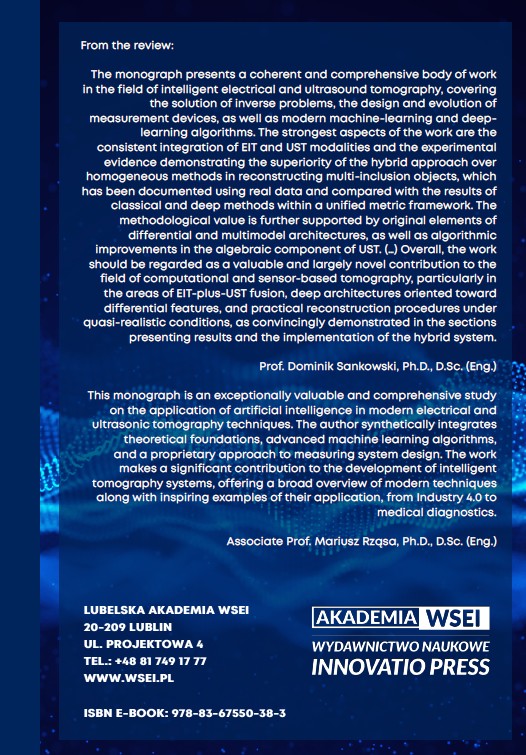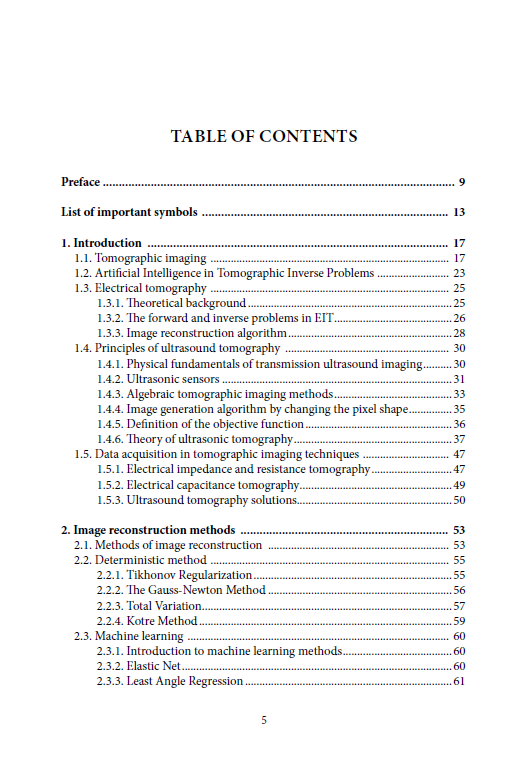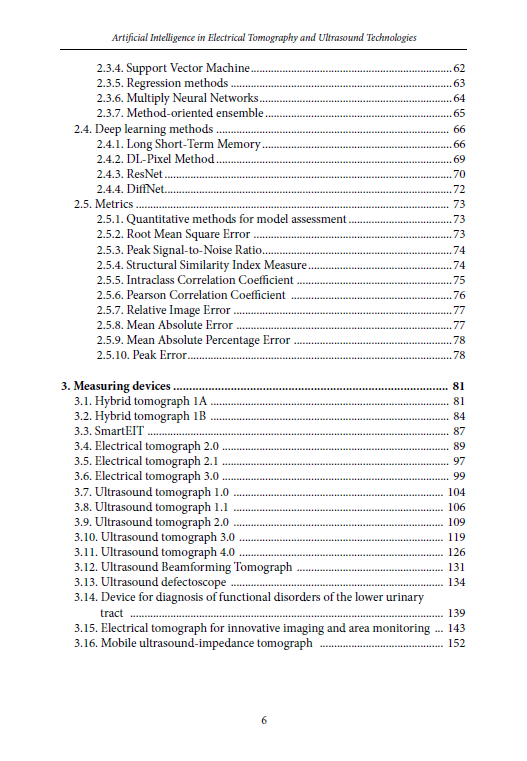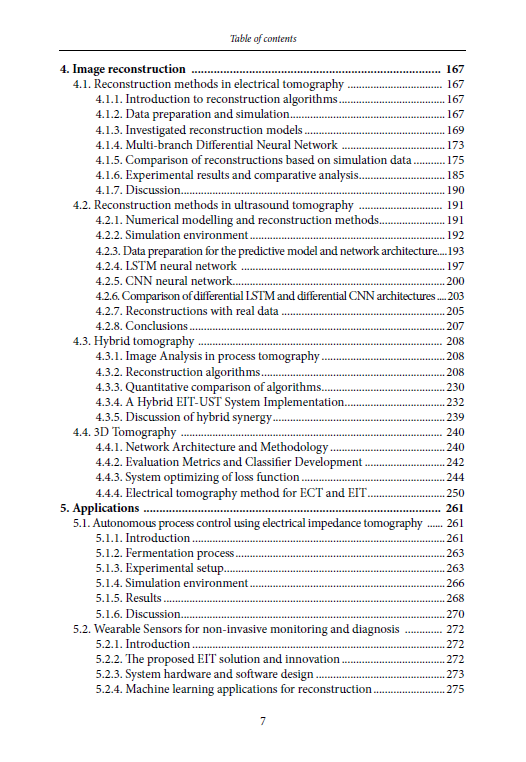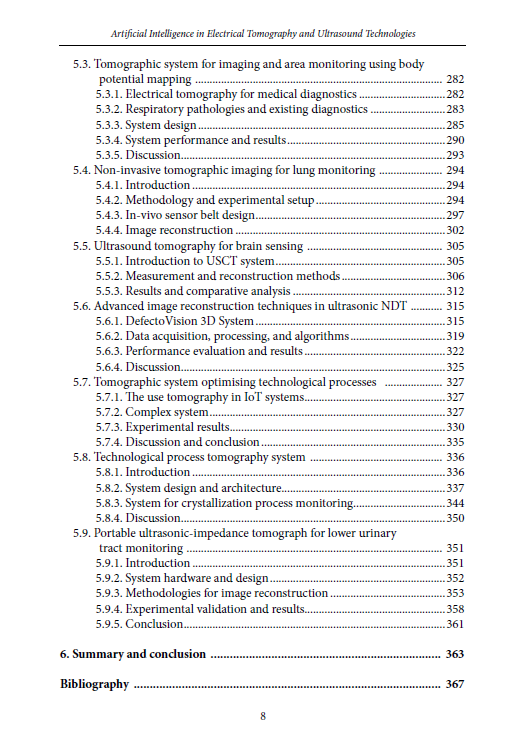Opis
This monograph aims to synthesize methods, measurement architectures, and algorithms that advance approaches to electrical and ultrasonic tomography, with a particular focus on artificial intelligence in image reconstruction and decision support. The work places these techniques in modern, complex environmental, industrial, and medical diagnostic systems, where non-invasive measurements are required for reliable observation, control, and process optimization. The scope of this work encompasses forward and inverse problems, numerical modelling, and data-driven learning methods, and is based on practical prototypes and verified applications.
Tomographic imaging is presented as a family of techniques that infer internal structure based on boundary or remote measurements, enabling inspection without physical intervention. The theoretical foundations are outlined along with historical context and standard formulations of inverse problems, which are ill-posed and sensitive to noise and modelling errors. Established numerical frameworks, such as the Finite Element Method, are used to regularize and solve forward and inverse problems for electric and acoustic fields. These pillars provide a coherent path from physics to computation, and ultimately to images interpreted in an operational context. Artificial intelligence methods were applied to improve reconstruction fidelity, noise immunity, and computational efficiency. The text discusses deterministic frameworks such as Tikhonov, Gauss-Newton, and Total Variation, followed by a discussion of machine learning and deep learning architectures such as LSTM and CNN, along with ResNet, DiffNet, and specifically developed differential models for tomographic signals. The proposed multi-branch and pixel-centric strategies were evaluated using quantitative metrics such as RMSE, SSIM, ICC, Pearson correlation, relative image error, MAE, MAPE, and related metrics that reflect both perceptual and task-specific quality. The combination of physics-based modeling and prior knowledge has been shown to reduce inference time and increase noise tolerance compared to classical iterative solvers.
A significant portion of the monograph is devoted to the design and evolution of measurement devices. Electrical and hybrid tomographs, next-generation ultrasound tomographs, a beamforming platform, and specialized flaw detection solutions are designed and characterized. Portable and mobile configurations, along with body potential mapping, are used to extend tomographic detection capabilities to include outpatient and situational monitoring. The measurement layer is integrated with distributed acquisition, synchronization, and embedded processing, allowing the systems to operate within industrial and clinical constraints.
Applications in process engineering and medicine are presented. Fermentation control, crystallization monitoring, and autonomous process supervision illustrate industrial utility, including connections to the Internet of Things and real-time data infrastructure. Medical research includes non-invasive lung monitoring, portable diagnostics, and ultrasound brain detection, as well as portable hybrid ultrasound impedance solutions for lower urinary tract assessment. Non-destructive testing is addressed using advanced ultrasound imaging on the DefectoVision platform, which describes 3D reconstruction and quantitative assessment. These cases demonstrate that tomographic sensing can reveal internal states, detect anomalies, and support inspection without disrupting production or compromising safety.
The book is designed to guide the reader from fundamentals to implementations and verified use cases. Chapter 1 introduces tomographic imaging, the physical principles underlying electrical and ultrasound techniques, and the challenges of the inverse problem. Chapter 2 discusses reconstruction methods, from deterministic regularization to machine learning and deep learning, along with evaluation metrics. Chapter 3 documents the designed measurement devices along with their electronics, sensor geometry, and system characteristics. Chapter 4 develops reconstruction processes based on simulated and experimental datasets and discusses comparative performance, including hybrid and 3D approaches. Chapter 5 consolidates applications in industrial processes and medical diagnostics, presenting experimental setups, results, and discussions that link quantitative metrics to operational requirements. Chapter 6 concludes with a summary, conclusions, and perspectives for further development.
This publication is aimed at researchers and PhD students in the fields of sensors, inverse problems, and computational imaging, as well as engineers and practitioners responsible for process control, non-destructive testing, and medical technology assessment. The material was developed autonomously, with theoretical assumptions, numerical methods, device descriptions, and application studies, so that knowledge can be transferred from laboratory prototypes to real systems.
This work was developed thanks to the research community and collaboration at the Netrix S.A. Research and Development Centre and the Institute of Information Technology and Innovative Technologies at the WSEI University in Lublin. Appreciation is expressed to my colleagues who collaborated with me on research projects in the areas of device prototyping, data acquisition, and algorithm development, which translated concepts into working systems. We also extend our gratitude to the reviewers, whose insightful comments contributed to improved clarity and completeness, and to our family for their continued support.
The presented projects were developed to demonstrate how intelligent tomographic measurement systems can be constructed and deployed as reliable imaging, monitoring, and control tools. This synthesis of physics-based modelling and learning-based reasoning will be useful to both academia and industry seeking to implement practical, large-scale tomography.


